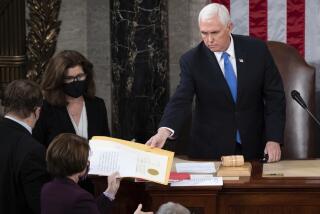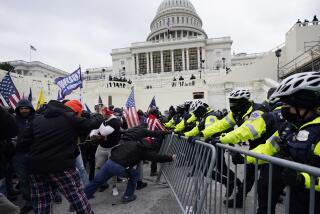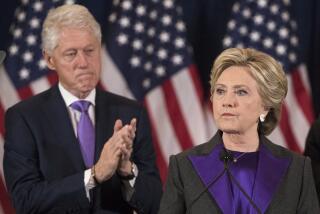Defense May Have Deflected Witnesses by Focusing on Facts
- Share via
WASHINGTON — The House Republicans who brought the impeachment charges against President Clinton have continually faulted the White House lawyers for ignoring the facts of the case. This week, they got what they asked for.
In three days of arguments, the president’s lawyers focused on the facts, and slowly and methodically picked apart the case constructed by the prosecutors.
By late Thursday, with opening arguments completed, the case against President Clinton looked smaller and less significant than before, perhaps no more than a foolish and failed attempt to conceal an embarrassing sexual affair with Monica S. Lewinsky.
Senators Hear No New Evidence
Since the trial began last week, the senators have heard no new evidence that showed the president himself urged the ex-intern to lie or to obstruct justice in the Paula Corbin Jones lawsuit. And the grand jury perjury charge against Clinton was shown to turn, not on whether he admitted his sexual encounters, but rather on a “he said, she said” dispute over whether he touched her in certain ways during those encounters.
Indeed, when the nation first heard about the Clinton-Lewinsky scandal a year ago Thursday, it looked to be a far more compelling legal case than it is now. Then, prosecutors under independent counsel Kenneth W. Starr thought they had stumbled upon White House witness tampering and obstruction of justice of staggering dimension.
On the secret phone tapes made by Linda Tripp, Lewinsky said she was promised a job by Clinton and his friend Vernon E. Jordan Jr. if she would lie to protect the president. And the infamous “talking points” memo referred to on the tapes was believed to show that someone in the White House, perhaps the president or his aide Bruce Lindsey, had carefully instructed Lewinsky on how to persuade Tripp to lie too.
But this compelling case dissolved after a second look. It turned out Lewinsky had made up the story of Jordan offering her a job in exchange for her silence. And it turned out she wrote the “talking points” on her own typewriter.
Though diminished, the case did not dissolve. Undaunted, Starr’s prosecutors changed their focus and built a case charging Clinton with having lied about Lewinsky in his deposition in the Jones sexual harassment case and having obstructed justice by thwarting Starr’s investigation.
The House then voted to impeach Clinton, though not exactly on those charges. Article I says he committed perjury in the grand jury in August in his description of the “nature and details” of his affair with Lewinsky; Article II says he obstructed justice by hiding potential evidence from Jones’ lawyers.
Case Weakened but Still Alive
So, after one year of investigation and one week of arguments on the articles of impeachment, the case against Clinton stands weakened but still alive.
What’s left is not as “fundamentally frivolous” or “trivial” as the president’s lawyers suggested this week. A suspicious set of circumstances remain. Jordan, a high-powered Washington lawyer, did scramble to find a job for the 24-year-old ex-White House intern in December 1997, and he spoke to the president repeatedly during these same weeks.
True, the prosecutors could not produce direct evidence that Clinton conspired with Jordan to get her the job for the purpose of keeping her silent. But despite the best efforts of the White House lawyers, they could not provide an entirely innocent explanation for all the sudden interest in Lewinsky’s employment prospects.
And Betty Currie, the president’s secretary, did hide under her bed a box of gifts given to Lewinsky by Clinton. White House Deputy Counsel Cheryl Mills explained that Currie was a friend--almost like a mother--to Lewinsky and hid the gifts as a favor. And no evidence pointed directly to Clinton as directing the operation, as the GOP prosecutors surmised. But the incident remains highly curious.
The prosecutors made much of the so-called coaching incident early last year, but the White House lawyers did an effective job of undercutting its legal significance.
On Jan. 18, 1998, a day after testifying in the Jones case, Clinton called Currie to work on a Sunday and asked her a series of leading questions regarding Lewinsky. “This is witness tampering, pure and simple,” charged House special counsel David Schippers last month.
Not so, said the White House lawyers, since Currie was not yet a witness and Clinton was not tampering. Jones’ lawyers had not asked to hear from Currie as a witness, and no one in the White House then knew the Starr investigation was about to expand into the Lewinsky affair.
Clinton was worried, however. He had heard of a Matt Drudge report on the Internet on Sunday morning that mentioned Lewinsky and Currie.
“His worst nightmare” was about to come true, White House special counsel Gregory Craig said. The whole world was about to learn about his secret and sordid affair with an intern.
The president was not thinking about “obstructing” a non-witness in the Jones case, Mills told the senators. He was thinking of a “media onslaught.”
The Senate must now decide whether it wants to delve further into the matter and, ultimately, whether the scandal justifies removing a president from office.
(BEGIN TEXT OF INFOBOX / INFOGRAPHIC)
How the Defense Answered the Charges
Article I: PERJURY
THE ACCUSATION: Clinton perjured himself before the grand jury when he testified on August 17, 1998, that his testimony in the Paula Jones case was truthful.
THE DEFENSE: Clinton is not being charged with perjury or obstruction of justice in the Jones case, so denying a crime when he is not being charged with one cannot be perjury.
THE ACCUSATION: Clinton committed perjury because in his prepared statement before the grand jury, he maintained that he engaged in inappropriate conduct with Monica Lewinsky in 1996 and once in 1997, when Lewinsky testified that they had sexual contact three times in 1995.
THE DEFENSE: Clinton admitted that he had been alone with Lewinsky and had engaged in inappropriate contact with her. To nitpick further is frivolous and unnecessary.
****
ARTICLE II OBSTRUCTION
THE ACCUSATION: It was implicit that Lewinsky would get assistance in her job search in exchange for filing a false affadavit about her relationship with Clinton.
THE DEFENSE: Lewinsky met with Vernon Jordan to discuss her employment opportunities on the morning of December 19, 1998--before a federal judge ruled later that day that she could be subpoenaed in the Jones case.
THE ACCUSATION: Clinton’s ongoing determination to keep the relationship with Lewinsky undiscovered was motivated by a desire to hurt the effectiveness of the sexual harrassment lawsuit brought about by Paula Jones.
THE DEFENSE: Clinton’s determination to hide his relationship with Lewinsky was a normal reaction by a man who had committed adultery. His behavior had more to do with shame and regret than with obstruction of justice. Also, the Jones case was politically motivated and was correctly dismissed by the judge as having no merit.
THE ACCUSATION: After he was asked in the Jones deposition specific questions about his relationship with Lewinsky, Clinton met with his secretary, Betty Currie, to review the questions he had been asked and the answers he gave. This was an attempt to take advantage of Currie’s loyalty and to influence her testimony.
THE DEFENSE: Clinton was dismayed to realize that his relationship with Lewinsky would inevitably be discovered by the media, and he was preparing for a grilling by newspeople, not preparing Currie for future testimony.
THE ACCUSATION: Clinton was instrumental in having Lewinsky give the subpoenaed gifts to Currie, who kept them under her bed.
THE DEFENSE: Neither Lewinsky nor Currie say Clinton was instrumental in the hiding oof the gifts. The most damning thing Lewinsky testified about this issue is that she asked him what to do with the gifts and he said, “Let me think about it.”
More to Read
Sign up for Essential California
The most important California stories and recommendations in your inbox every morning.
You may occasionally receive promotional content from the Los Angeles Times.














